-

新人教版高中英语选修2Unit 2 Using langauge-Listening教学设计
? B: Absolutely! Getting involved with Chinese cultural activities there definitely helped a lot. I got to practice my Chinese on a daily basis, and I could learn how native Chinese speakers spoke.? A: What do you feel is your biggest achievement?? B: Learning Chinese characters! I have learnt about 1,500 so far. When I first started, I didn't think it was even going to be possible to learn so many, but now I find that I can read signs, menus, and even some easy newspaper articles.? A: What are you most keen on?? B: I've really become keen on learning more about the Chinese culture, in particular Chinese calligraphy. As I have learnt Chinese characters, I have developed a great appreciation for their meaning. I want to explore Chinese characters by learning how to write them in a more beautiful way. ? A: Finally, what do you want to say to anyone interested in learning Chinese?? I have really become keen on learning more about the Chinese culture, in particular Chinese Calligraphy. As I have learnt Chinese character, I have developed a great appreciation for their meaning. I want to explore Chinese characters by learning how to write them in a more beautiful way.? A: Finally, what do you want to say to anyone interested in learning Chinese?? B: I'd say, give it a shot! While some aspects may be difficult, it is quite rewarding and you will be happy that you tried.? A: Thanks for your time. ? B:You're welcome.

新人教版高中英语选修2Unit 3 Using langauge-Listening教学设计
1. How is Hunan cuisine somewhat different from Sichuan cuisine?The heat in Sichuan cuisine comes from chilies and Sichuan peppercorns. Human cuisine is often hotter and the heat comes from just chilies.2.What are the reasons why Hunan people like spicy food?Because they are a bold people. But many Chinese people think that hot food helps them overcome the effects of rainy or wet weather.3.Why do so many people love steamed fish head covered with chilies?People love it because the meat is quite tender and there are very few small bones.4.Why does Tingting recommend bridge tofu instead of dry pot duck with golden buns?Because bridge tofu has a lighter taste.5 .Why is red braised pork the most famous dish?Because Chairman Mao was from Hunan, and this was his favorite food.Step 5: Instruct students to make a short presentation to the class about your choice. Use the example and useful phrases below to help them.? In groups of three, discuss what types of restaurant you would like to take a foreign visitor to, and why. Then take turns role-playing taking your foreign guest to the restaurant you have chosen. One of you should act as the foreign guest, one as the Chinese host, and one as the waiter or waitress. You may start like this:? EXAMPLE? A: I really love spicy food, so what dish would you recommend?? B: I suggest Mapo tofu.? A: Really ? what's that?

新人教版高中英语选修2Unit 4 Learning about Language教学设计
This section guides students to pay attention to the typical context of vocabulary use, helps students accumulate vocabulary around the key vocabulary of this unit, and uses the learned words and word chunks in different contexts to deeply understand their meaning and usage, so as to achieve the purpose of review and consolidation.The teaching design activities aim to guide students to pay attention to the typical context in which the target vocabulary is used, as well as the common vocabulary used in collocation, so that students can complete the sentence with correct words. In terms of vocabulary learning strategies, this unit focuses on cultivating students' ability to pay attention to collocation of words and to use word blocks to express meaning.For vocabulary learning, it is not enough just to know the meaning of a single word, but the most important thing is to master the common collocations of words, namely word blocks.Teachers should timely guide students to summarize common vocabulary collocation, such as verb and noun collocation, verb and preposition collocation, preposition and noun collocation, and so on.1. Guide students to understand and consolidate the meaning and usage of the vocabulary in the context, 2. Guide the students to use the unit topic vocabulary in a richer context3. Let the students sort out and accumulate the accumulated vocabulary, establishes the semantic connection between the vocabulary,4. Enable students to understand and master the vocabulary more effectivelyGuiding the Ss to use unit topic words and the sentence patterns in a richer context.

新人教版高中英语选修2Unit 4 Reading for writing教学设计
假定你是英国的Jack,打算来中国旅行,请你给你的中国笔友李华写一封信,要点如下:1.你的旅行计划:北京→泰山→杭州;2.征求建议并询问他是否愿意充当你的导游。注意:1.词数80左右(开头和结尾已给出,不计入总词数);2.可以适当增加细节,以使行文连贯。参考词汇:故宫 the Forbidden City;泰山 Mount TaiDear Li Hua,I'm glad to tell you that 'm going to visit China.First,I am planning to visit Beijing,the capitalof China,where I am looking forward to enjoying the Great Wall,the Forbidden City and somebeautiful parks.Then I intend to go to visit Mount Tai in Shandong Province.I've heard that it is one ofthe most famous mountains in China and I can't wait to enjoy the amazing sunrise there.After that,I amalso going to Hangzhou.It is said that it is a beautiful modern city with breathtaking natural sights,among which the West Lake is a well- known tourist attraction.What do you think of my travel plan? Will you act as my guide? Hope to hear from you soon.

新人教版高中英语选修2Unit 4 Using langauge-Listening教学设计
The theme of the listening section is " talking about scenery and culture along a journey."The part is designed to further lead the students to understand Canadian natural geography and social environment, and integrated into the cultural contrast by mentioning the long train journey from Beijing to Moscow routes. On this basis, the part activates students related travel experience, lets the student serial dialogue, guides the student to explore further the pleasure and meaning of the long journey, and Chinese and foreign cultural comparison.The part also provides a framework for the continuation of the dialogue, which is designed to provide a framework for students to successfully complete their oral expressions, and to incorporate an important trading strategy to end the dialogue naturally.1. Help students to understand and master some common English idioms in the context, and experience the expression effect of English idioms.2. Guide the students to understand the identity of different people in the listening context, and finish the dialogue according to their own experience.3. Instruct the students to use appropriate language to express surprise and curiosity about space and place in the dialogue, and master the oral strategy of ending the dialogue naturally.1. Instruct students to grasp the key information and important details of the dialogue.2. Instruct students to conduct a similar talk on the relevant topic.

新人教版高中英语选修2Unit 5 Learning about Language教学设计
The purpose of this section of vocabulary exercises is to consolidate the key words in the first part of the reading text, let the students write the words according to the English definition, and focus on the detection of the meaning and spelling of the new words. The teaching design includes use English definition to explain words, which is conducive to improving students' interest in vocabulary learning, cultivating their sense of English language and thinking in English, and making students willing to use this method to better grasp the meaning of words, expand their vocabulary, and improve their ability of vocabulary application. Besides, the design offers more context including sentences and short passage for students to practice words flexibly.1. Guide students to understand and consolidate the meaning and usage of the vocabulary in the context, 2. Guide the students to use the unit topic vocabulary in a richer context3. Let the students sort out and accumulate the accumulated vocabulary, establishes the semantic connection between the vocabulary,4. Enable students to understand and master the vocabulary more effectivelyGuiding the Ss to use unit topic words and the sentence patterns in a richer context.Step1: Read the passage about chemical burns and fill in the blanks with the correct forms of the words in the box.

新人教版高中英语选修2Unit 5 Reading and thinking教学设计
The theme of this activity is to learn the first aid knowledge of burns. Burns is common in life, but there are some misunderstandings in manual treatment. This activity provides students with correct first aid methods, so as not to take them for granted in an emergency. This section guides students to analyze the causes of scald and help students avoid such things. From the perspective of text structure and collaborative features, the text is expository. Expository, with explanation as the main way of expression, transmits knowledge and information to readers by analyzing concepts and elaborating examples. This text arranges the information in logical order, clearly presents three parts of the content through the subtitle, accurately describes the causes, types, characteristics and first aid measures of burns, and some paragraphs use topic sentences to summarize the main idea, and the level is very clear.1. Guide students to understand the causes, types, characteristics and first aid methods of burns, through reading2. Enhance students’ ability to deal withburnss and their awareness of burns prevention3. Enable students to improve the ability to judge the types of texts accurately and to master the characteristics and writing techniques of expository texts.Guide students to understand the causes, types, characteristics and first aid methods of burns, through readingStep1: Lead in by discussing the related topic:1. What first-aid techniques do you know of ?CPR; mouth to mouth artificial respiration; the Heimlich Manoeuvre

新人教版高中英语选修2Unit 5 Using langauge-Listening教学设计
The theme of this section is to learn how to make emergency calls. Students should learn how to make emergency calls not only in China, but also in foreign countries in English, so that they can be prepared for future situations outside the home.The emergency telephone number is a vital hotline, which should be the most clear, rapid and effective communication with the acute operator.This section helps students to understand the emergency calls in some countries and the precautions for making emergency calls. Through the study of this section, students can accumulate common expressions and sentence patterns in this context. 1.Help students accumulate emergency telephone numbers in different countries and learn more about first aid2.Guide the students to understand the contents and instructions of the telephone, grasp the characteristics of the emergency telephone and the requirements of the emergency telephone.3.Guide students to understand the first aid instructions of the operators.4.Enable Ss to make simulated emergency calls with their partners in the language they have learned1. Instruct students to grasp the key information and important details of the dialogue.2. Instruct students to conduct a similar talk on the relevant topic.Step1:Look and discuss:Match the pictures below to the medical emergencies, and then discuss the questions in groups.
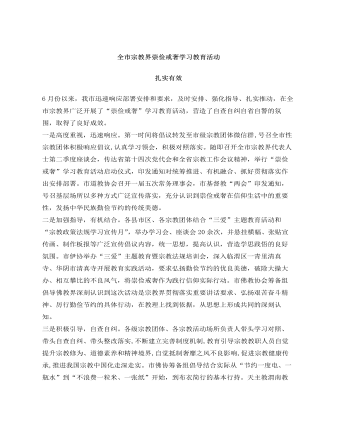
全市宗教界崇俭戒奢学习教育活动总结汇报
天主教渭南教区举行“崇俭戒奢”教育活动座谈会,进一步统一思想认识,清醒认识宗教领域贪大求奢、借教敛财、铺张浪费等不良风气的严重危害,突出问题导向,坚持自查自改,要求秉持俭朴理念,发扬勤俭节约、朴实无华、清净庄严等优良传统,使厉行节约、崇尚简朴的理念在全市天主教界蔚然成风。四是固化经验,常抓抓常。按照省民宗委、各全省性宗教团体统一部署要求和总体安排,一是结合“三爱”主题教育和爱国主义教育活动,广泛深入推进“崇俭戒奢”宣传教育,以实际行动响应倡议,以实际成效树立形象,扎实推进我国宗教中国化。二是引导各级宗教团体持续拓展中国化内涵,把“三爱”主题教育与“四进”活动相结合,突出自身特点、时代精神、中国特色,推动“崇俭戒奢”教育活动深入人心、落地见效。三是督导各宗教场所提高站位、深化认识,发扬宗教适应社会、服务社会的优良传统,增强政治自觉和行动自觉,为社会主义现代化和中华民族伟大复兴更好的发挥宗教积极作用。
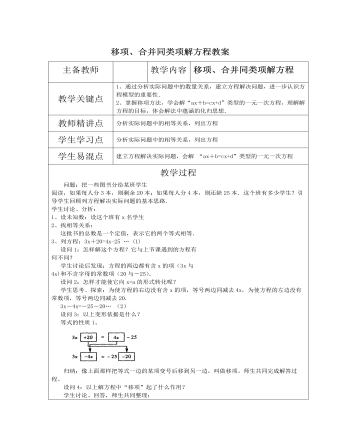
北师大初中七年级数学上册利用移项与合并同类项解一元一次方程教案2
练习:现在你能解答课本85页的习题3.1第6题吗?有一个班的同学去划船,他们算了一下,如果增加一条船,正好每条船坐6人,如果送还了一条船 ,正好每条船坐9人,问这个班共多少同学?小结提问:1、今天你又学会了解方程的哪些方法?有哪些步聚?每一步的依据是什么?2、现在你能回答前面提到的古老的代数书中的“对消”与“还原”是什么意思吗?3、今天讨论的问题中的相等关系又有何共同特点?学生思考后回答、整理:① 解方程的步骤及依据分别是:移项(等式的性质1)合并(分配律)系数化为1(等式的性质2)表示同一量的两个不同式子相等作业:1、 必做题:课本习题2、 选做题:将一块长、宽、高分别为4厘米、2厘米、3厘米的长方体橡皮泥捏成一个底面半径为2厘米的圆柱,它的高是多少?(精确到0.1厘米)
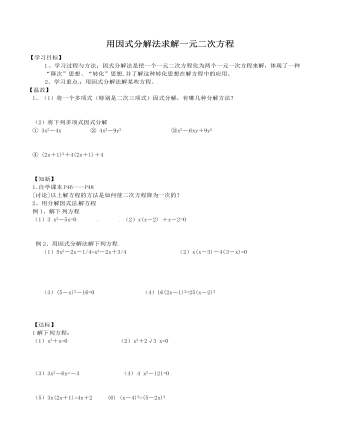
北师大初中数学九年级上册用因式分解法求解一元二次方程2教案
【学习目标】1 、学习过程与方法:因式分解法是把一个一元二次方程化为两个一元一次方程来解,体现了一种“降次”思想、“转化”思想,并了解这种转化思想在解方程中的应用。2、学习重点 :用因式分解法解某些方程。 【温故】1、(1)将一个多项式(特别是二次三项式)因式分解,有哪几种分解方法?(2)将下列多项式因式分解① 3x2-4x ② 4x2-9y2 ③x2- 6xy+9y2④ (2x+1)2+4(2x+1)+4 【知新】1.自学课本 P46----P48[讨论]以上解方程的方法是如何使二次方程降为一次的?2、用分解因式法 解方程例1、解下 列方程(1)3 x2-5x=0 (2)x(x-2) +x-2=0例2、用因式分解法解下列方程 (1)5x2-2x-1/4=x2-2x+3/4 (2)x(x-3)-4( 3-x)=0 (3)(5-x)2-16=0 (4)16(2x-1)2=25(x-2)2
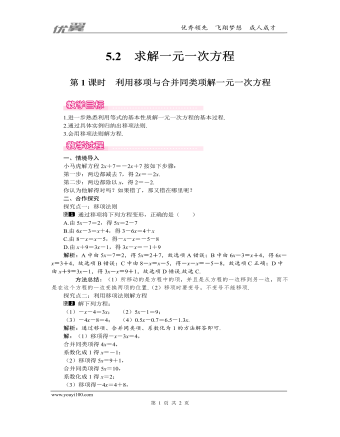
北师大初中七年级数学上册利用移项与合并同类项解一元一次方程教案1
(3)移项得-4x=4+8,合并同类项得-4x=12,系数化成1得x=-3;(4)移项得1.3x+0.5x=0.7+6.5,合并同类项得1.8x=7.2,系数化成1得x=4.方法总结:将所有含未知数的项移到方程的左边,常数项移到方程的右边,然后合并同类项,最后将未知数的系数化为1.特别注意移项要变号.探究点三:列一元一次方程解应用题把一批图书分给七年级某班的同学阅读,若每人分3本,则剩余20本,若每人分4本,则缺25本,这个班有多少学生?解析:根据实际书的数量可得相应的等量关系:3×学生数量+20=4×学生数量-25,把相关数值代入即可求解.解:设这个班有x个学生,根据题意得3x+20=4x-25,移项得3x-4x=-25-20,合并同类项得-x=-45,系数化成1得x=45.答:这个班有45人.方法总结:列方程解应用题时,应抓住题目中的“相等”、“谁比谁多多少”等表示数量关系的词语,以便从中找出合适的等量关系列方程.
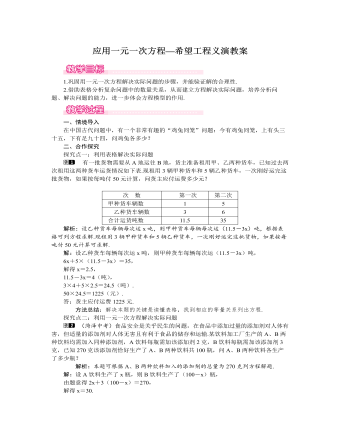
北师大初中七年级数学上册应用一元一次方程——“希望工程”义演教案1
方法总结:解题关键是要读懂题目的意思,根据题目给出的条件,找出合适的等量关系,列出方程再求解.探究点三:工程问题一个道路工程,甲队单独施工9天完成,乙队单独做24天完成.现在甲乙两队共同施工3天,因甲另有任务,剩下的工程由乙队完成,问乙队还需几天才能完成?解析:首先设乙队还需x天才能完成,由题意可得等量关系:甲队干三天的工作量+乙队干(x+3)天的工作量=1,根据等量关系列出方程,求解即可.解:设乙队还需x天才能完成,由题意得:19×3+124(3+x)=1,解得:x=13.答:乙队还需13天才能完成.方法总结:找到等量关系是解决问题的关键.本题主要考查的等量关系为:工作效率×工作时间=工作总量,当题中没有一些必须的量时,为了简便,应设其为1.三、板书设计“希望工程”义演题目特点:未知数一般有两个,等量关系也有两个解题思路:利用其中一个等量关系设未知数,利用另一个等量关系列方程
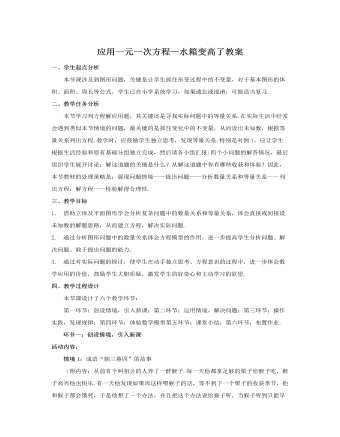
北师大初中七年级数学上册应用一元一次方程——水箱变高了教案2
从而为列方程找等量关系作了铺垫.环节2中的表格发给每个小组,为增强小组讨论结果的展示起到了较好的作用.环节3中通过让学生自己设计表格为讨论的得出起到辅助作用.2.相信学生并为学生提供充分展示自己的机会本节课的设计中,通过学生多次的动手操作活动,引导学生进行探索,使学生确实是在旧知识的基础上探求新内容,探索的过程是没有难度的任何学生都会动手操作,每个学生都有体会的过程,都有感悟的可能,这种形式让学生切身去体验问题的情景,从而进一步帮助学生理解比较复杂的问题,再把实际问题抽象成数学问题.3.注意改进的方面本节课由于构题新颖有趣,所以一开始就抓住了学生的求知欲望,课堂气氛活跃,讨论问题积极主动.但由于学生发表自己的想法较多,使得教学时间不能很好把握,导致课堂练习时间紧张,今后予以改进.
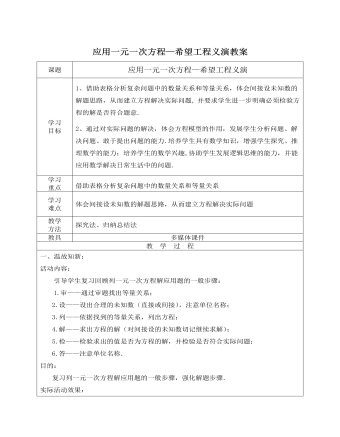
北师大初中七年级数学上册应用一元一次方程——“希望工程”义演教案2
1:甲、乙、丙三个村庄合修一条水渠,计划需要176个劳动力,由于各村人口数不等,只有按2:3:6的比例摊派才较合理,则三个村庄各派多少个劳动力?2:某校组织活动,共有100人参加,要把参加活动的人分成两组,已知第一组人数比第二组人数的2倍少8人,问这两组人数各有多少人?目的:检测学生本节课掌握知识点的情况,及时反馈学生学习中存在的问题.实际活动效果:从学生做题的情况看,大部分学生都能正确地列出方程,但其中一部分人并不能有意识地用“列表格”法来分析问题,因此,教师仍需引导他们能学会用“列表格”这个工具,有利于以后遇上复杂问题能很灵活地得到解决.六、归纳总结:活动内容:学生归纳总结本节课所学知识:1. 两个未知量,两个等量关系,如何列方程;2. 寻找中间量;3. 学会用表格分析数量间的关系.
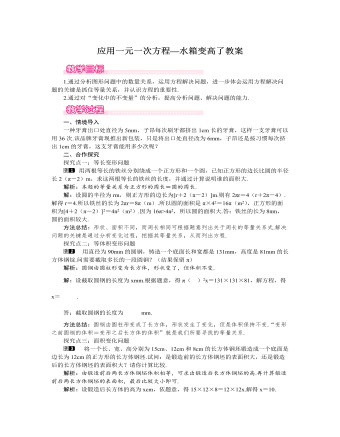
北师大初中七年级数学上册应用一元一次方程——水箱变高了教案1
解:设截取圆钢的长度为xmm.根据题意,得π(902)2x=131×131×81,解方程,得x=686.44π.答:截取圆钢的长度为686.44πmm.方法总结:圆钢由圆柱形变成了长方体,形状发生了变化,但是体积保持不变.“变形之前圆钢的体积=变形之后长方体的体积”就是我们所要寻找的等量关系.探究点三:面积变化问题将一个长、宽、高分别为15cm、12cm和8cm的长方体钢坯锻造成一个底面是边长为12cm的正方形的长方体钢坯.试问:是锻造前的长方体钢坯的表面积大,还是锻造后的长方体钢坯的表面积大?请你计算比较.解析:由锻造前后两长方体钢坯体积相等,可求出锻造后长方体钢坯的高.再计算锻造前后两长方体钢坯的表面积,最后比较大小即可.解析:设锻造后长方体的高为xcm,依题意,得15×12×8=12×12x.解得x=10.锻造前长方体钢坯的表面积为2×(15×12+15×8+12×8)=2×(180+120+96)=792(cm2),锻造后长方体钢坯的表面积为2×(12×12+12×10+12×10)=2×(144+120+120)=768(cm2).
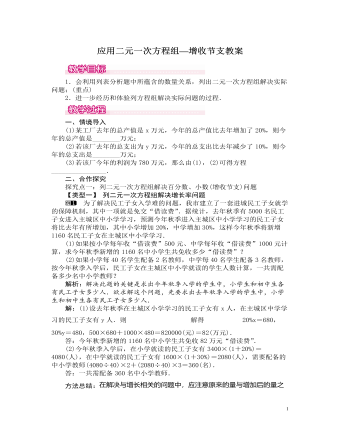
北师大初中数学八年级上册应用二元一次方程组——增收节支1教案
因为x3表示手机部数,只能为正整数,所以这种情况不合题意,应舍去.综上所述,商场共有两种进货方案.方案1:购甲型号手机30部,乙型号手机10部;方案2:购甲型号手机20部,丙型号手机20部.(2)方案1获利:120×30+80×10=4400(元);方案2获利:120×20+120×20=4800(元).所以,第二种进货方案获利最多.方法总结:仔细读题,找出相等关系.当用含未知数的式子表示相等关系的两边时,要注意不同型号的手机数量和单价要对应.三、板书设计增收节支问题分析解决列二元一次方程,组解决实际问题)增长率问题利润问题利用图表分析等量关系方案选择通过问题的解决使学生进一步认识数学与现实世界的密切联系,乐于接触生活环境中的数学信息,愿意参与数学话题的研讨,从中懂得数学的价值,逐步形成运用数学的意识;并且通过对问题的解决,培养学生合理优化的经济意识,增强他们的节约和有效合理利用资源的意识.
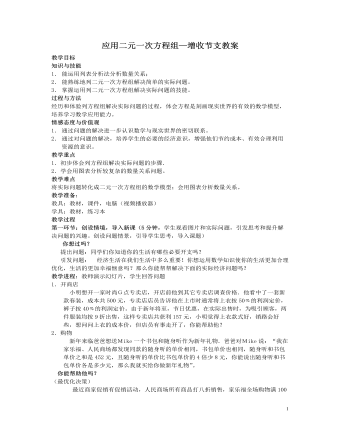
北师大初中数学八年级上册应用二元一次方程组——增收节支2教案
答:书包单价92元,随身听单价360元。最优化决策:聪明的Mike想了想回答正确后便同爸爸去买礼物,恰好赶上商家促销,人民商场所有商品打八折销售,家乐福全场购物满100元返购物券30元销售(不足100元不返券,购物券全场通用),但他只带了400元钱,如果他只在一家购买看中的这两样物品,你能帮助他选择在哪一家购买吗?若两家都可以选择,在哪一家购买更省钱?提示:书包单价92元,随身听单价360元。2)在人民商场购买随声听与书包各一样需花费现金452× =361.6(元)∵ 361.6<400 ∴可以选择在人民商场购买。在家乐福可先花现金360元购买随身听,再利用得到的90元返券,加上2元现金购买书包,共花现金360+2=362(元)。因为362<400,所以也可以选择在家乐福购买。因为362>361.6,所以在人民商场购买更省钱。第五环节:学习反思;(5分钟,学生思考回答,不足的地方教师补充和强调。)
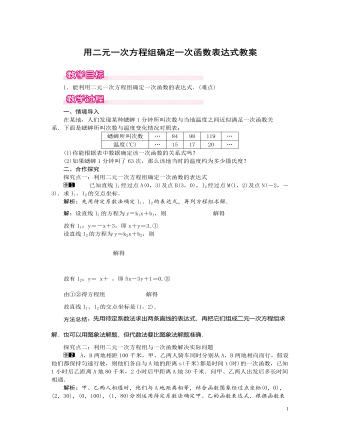
北师大初中数学八年级上册用二元一次方程组确定一次函数表达式1教案
故直线l2对应的函数关系式为y=52x.故(-2,-5)可看成是二元一次方程组5x-2y=0,2x-y=1的解.(3)在平面直角坐标系内画出直线l1,l2的图象如图,可知点A(0,-1),故S△APO=12×1×2=1.方法总结:此题在待定系数法的应用上有所创新,并且把一次函数的图象和三角形面积巧妙地结合起来,既考查了基本知识,又不局限于基本知识.三、板书设计利用二元一次方程组确定一次函数表达式的一般步骤:1.用含字母的系数设出一次函数的表达式:y=kx+b(k≠0);2.将已知条件代入上述表达式中得k,b的二元一次方程组;3.解这个二元一次方程组得k,b的值,进而得到一次函数的表达式.通过教学,进一步理解方程与函数的联系,体会知识之间的普遍联系和知识之间的相互转化.通过对本节课的探究,培养学生的观察能力、识图能力以及语言表达能力.

北师大初中数学九年级上册利用一元二次方程解决面积问题2教案
四.知识梳理谈谈用一元二次方程解决例1实际问题的方法。五、目标检测设计1.如图,宽为50cm的矩形图案由10个全等的小长方形拼成,则每个小长方形的面积为( ).【设计意图】发现几何图形中隐蔽的相等关系.2.镇江)学校为了美化校园环境,在一块长40米、宽20米的长方形空地上计划新建一块长9米、宽7米的长方形花圃.(1)若请你在这块空地上设计一个长方形花圃,使它的面积比学校计划新建的长方形花圃的面积多1平方米,请你给出你认为合适的三种不同的方案.(2)在学校计划新建的长方形花圃周长不变的情况下,长方形花圃的面积能否增加2平方米?如果能,请求出长方形花圃的长和宽;如果不能,请说明理由.【设计意图】考查学生的审题能力及用一元二次方程模型解决简单的图形面积问题.


